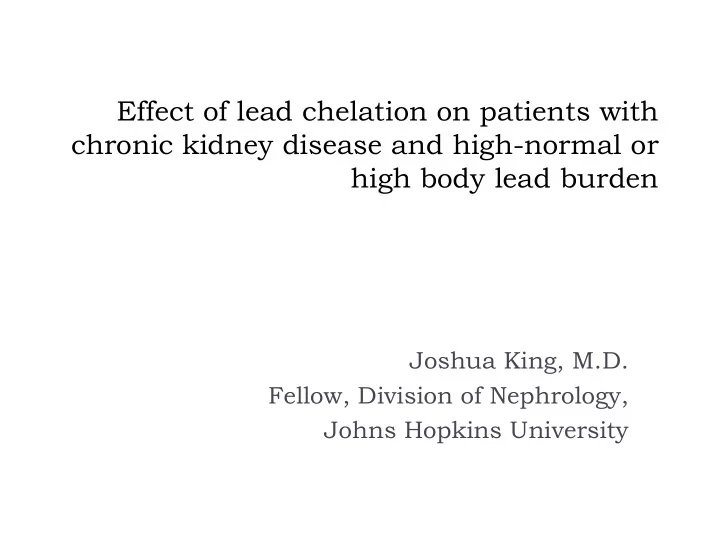

Effect of lead chelation on patients with chronic kidney disease and high-normal or high body lead burden Joshua King, M.D. Fellow, Division of Nephrology, Johns Hopkins University
Background Chronic lead toxicity is associated with increased risk for chronic kidney disease (CKD) as well as progressive decline in kidney function Patients with higher blood lead levels, even those within the normal range, have a higher risk of CKD This risk has been demonstrated independently of a history of known significant lead exposure Ekong EB, Kidney Int 2006 Tsiah SW, Environ Health Perspect 2004
Background Ethylene diamine tetraacetate (EDTA), a chelating agent used to measure body-lead burden, has been used safely in diagnostic and therapeutic settings Wedeen RP, Environ Res 1983 Lin JL, Kidney Int 2001 Treatment with EDTA has slowed the progression of CKD in animals and patients in Taiwan with high-normal body lead burden Lin-Tan D, Nephrol Dial Transplant 2007 Roncal C, Am J Physiol Renal Physiol 2007 We aim to determine whether lead chelation therapy could be used to treat a subpopulation of American patients with CKD
Null Hypothesis Among patients with moderate CKD and high-normal or high body lead burden, treatment with EDTA will not significantly reduce the rate of decline in kidney function by 3 mL/min/1.73 m 2 per year compared to treatment with placebo
Null Hypothesis High-normal body lead burden defined as a body lead burden 60-600 µ g mobilized with EDTA over a 72-hour urinary collection High body lead burden defined as a body lead burden >600 µ g Moderate CKD defined as glomerular filtration rates (GFR) of 20-50 mL/min/1.73 m 2 as estimated by the CKD-EPI equation
Study Population Patients aged 18-80 years with a history of CKD with glomerular filtration rates (GFR) of 20-50 mL/min/1.73 m 2 as estimated by the CKD-EPI equation Recruitment sites: Johns Hopkins Nephrology and Internal Medicine clinics Patients will be screened upon entry with a 72-hour urine collection after EDTA mobilization Those with ≤60 µ g of lead in a 72-hour urine collection will be excluded from the study
Study Population Exclusion criteria: A history of kidney disease due to a potentially reversible cause Systolic BP >160 mm Hg or diastolic BP >90 mm Hg Hemoglobin A1c >7.5% Proteinuria >5 grams/1.73 m 2 per 24 hours Known disease other than diabetes causing glomerulopathy
Methods Study design: Double-blinded, randomized, placebo- controlled trial Patients will be treated with an initial period of chelation with either 1g of EDTA or a saline placebo suspended in 200 mL of normal saline intravenously weekly for 4 weeks Body lead burden will then be assessed annually for 3 years, and repeat treatment with EDTA or placebo will be given for patients whose body lead burden remains above 60 micrograms
Yearly BLB, GFR Enrolled 4 weekly assessment patients treatments with for 3 years; EDTA EDTA repeat BLB >60 µ g : therapy if BLB >60 µ g randomized 72-hour lead Data urine collection analysis Yearly BLB, GFR 4 weekly BLB ≤60 µ g assessment treatments with Placebo for 3 years; placebo repeat Excluded therapy if BLB >60 µ g
Methods Primary outcome: Annual rate of change in GFR over the duration of the study Secondary outcomes: Need for renal replacement therapy, change in blood pressure, change in proteinuria, mortality
Methods Power calculations suggest that a sample size of 64 patients per group would be needed to achieve a power level of 0.80 and alpha error of less than 0.05 Estimated for two-sample t-test with a standard deviation of twice the observed difference in GFR Assuming drop-out rate of 10%, would aim to enroll 71 patients per group Statistical methods: Mixed-level modeling for rate of progression of GFR, blood pressure, proteinuria Kaplan-Meier survival analysis for initiation of renal replacement therapy and mortality
Significance Very few therapies exist to prevent progression of CKD The use of EDTA in patients with CKD and moderate body lead burden to delay the progression of CKD could reduce the number of patients who ultimately require kidney transplantation or dialysis Our nationwide health care system is ill-equipped to absorb the growing burden of patients with end-stage renal disease
Acknowledgments Derek Fine Michelle Estrella Charles Flexner Kit Carson Mitch Rosner, Chris Holstege, Kevin Wallace Renal fellows extraordinaire: Teresa Chen, Matt Foy, Tanya Johns, Manny Monroy-Trujillo Small Group: Steve Chang, Peter Peng, Sam Pitts, Aditi Puri, Maggie Seide
Recommend
More recommend